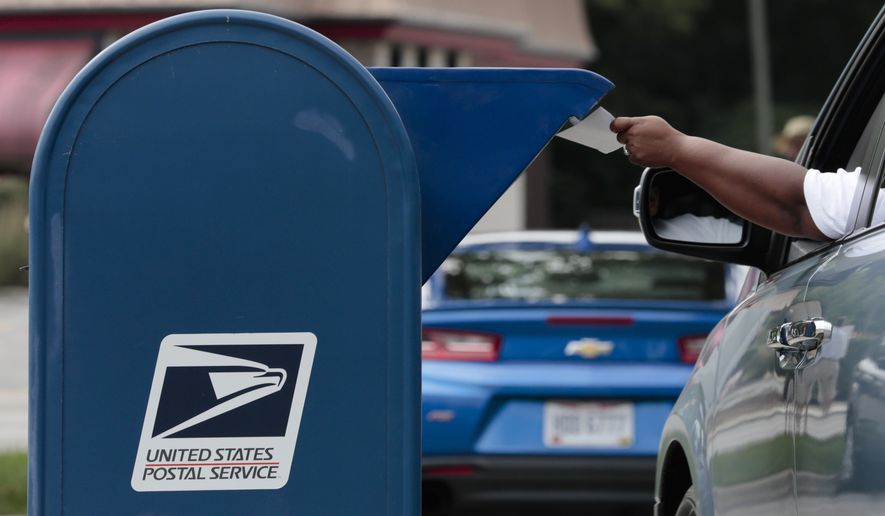The U.S. Postal Service, under Democratic fire on its readiness for mail-in voting, says there are big problems on the other end, too.
Some local election boards count ballots using outdated procedures as the country prepares for its first mass-mail vote.
The boards opted to use excess envelopes, minus bar codes, making it impossible to track the ballot applications or ballots, the U.S. Postal Service inspector general said in a new report this week.
The inspector general said that in 2018, 31 million ballots were cast by mail. Only 4 million, or 13%, used mail tracking technology.
“The Postal Service, mailers, and election boards are not able to track ballot envelopes that do not have barcodes,” the IG said. “According to Postal Service management, some election boards have chosen to continue using excess stock of ballot envelopes without barcodes and some lack the funding for integrating the use of barcodes in their mailing process.”
The gap comes despite the Postal Service repeatedly telling election boards over the years to make sure pieces can be tracked. USPS also has also been urging canvassing boards to ensure they have the correct addresses for voters to avoid huge numbers of ballots being returned unopened.
Other problems the inspector general found:
- Boards are using envelopes that can cause the ballot to be sent back to the voter instead of counted because they contain two addresses.
- Boards are planning on sending ballots too close to election day for carriers to meet state deadlines. Officials should mail ballots at least 15 days before Nov. 3, yet 48 states let voters request absentee ballots inside that time span.
- There is a muddle of different requirements for post marks. Nearly 30 states have no requirement. The other states have different dates for when the ballot can be counted.
- States have no consistent policies for updating voter lists. “This can cause absentee ballots intended for voters to be returned to election officials as undeliverable,” the IG said.
Such was the case in Nevada, where Democrats quickly shifted to an all-mail election and sent hundreds of thousands of ballots off voters lists even if not requested.
The Public Interest Legal Foundation said Nevada’s Clark County opted for actual ballots, not applications, to all listed voters in the state’s June primary.
Las Vegas-centric Clark County, Nevada’s largest, mailed 1.3 million ballots; USPS determined 223,469 were undeliverable. Voters filled out and returned 305,008.
“These numbers show how vote by mail fails,” said PILF President J. Christian Adams.
His group found that in the last four elections, Nevada reported only 5,863 returned undeliverable ballots.
Mr. Adams said developing a workable mass-mail election takes time. States are now trying to cram a totally new system into a few months planning time because of the COVID-19 pandemic.
“New proponents of mail balloting don’t often understand how it actually works,” Mr. Adams said. “States like Oregon and Washington spent many years building their mail voting systems and are notably aggressive with voter list maintenance efforts. Pride in their own systems does not somehow transfer across state lines. Nevada, New York, and others are not and will not be ready for November.”
Responding to the report, legal foundation spokesman Logan Churchwell told The Washington Times: “The postal service is correct to note that recipient addresses are out of date. For years, we’ve raised alarm about bloated and outdated voter registration records that, if used as the foundation for a mail ballot election, could be catastrophic. Just like ’going to war with the army you have,’ we’re doing the same with voter addresses. In 2020, dead people and those holding duplicated registrations will get ballots. “
President Trump took a look at Nevada’s new system and declared it Illegal. His campaign quickly filed a lawsuit in early August.
Nevada will steal an idea from California and allow “ballot harvesting” for the general election. Anyone can collect ballots and bring them to a polling place.
Democrats have accused Postmaster General Louis DeJoy of being in some type of conspiracy to constrain mail-voting
“There are many inaccuracies about my actions that I wish to again correct,” Mr. DeJoy testified at a House hearing last month. “First, I did not direct the removal of blue collection boxes or the removal of mail processing equipment. Second, I did not direct the cutback on hours at any of our postal offices, and finally I did not direct the elimination or any cutback in overtime. I did, however, suspend these practices to remove any misperceptions about our commitment to delivering the nation’s election mail.”
• Rowan Scarborough can be reached at rscarborough@washingtontimes.com.




Please read our comment policy before commenting.